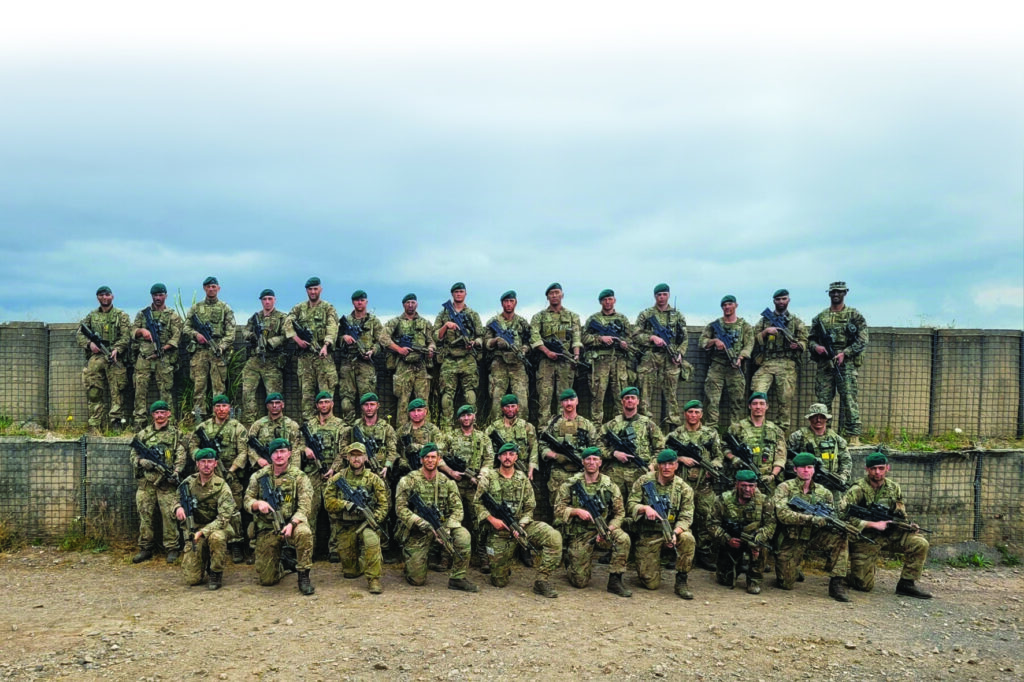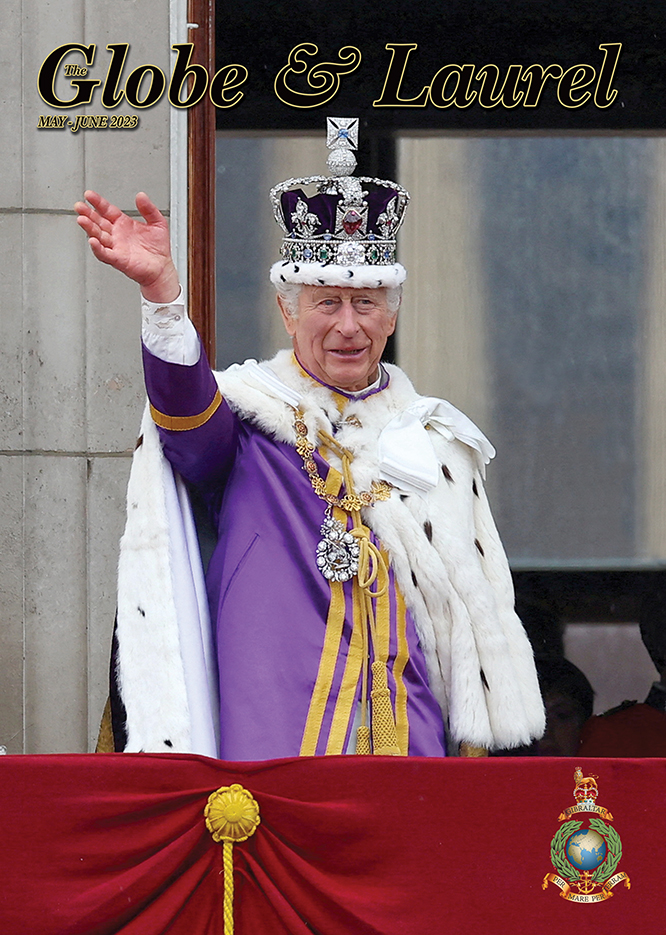The following article is taken from the latest issue of the Globe & Laurel magazine.
Click the button below to discover more.

Ex Campbell Hardy 2023
‘Living the Commando Force Advert’
In November 1948, the Royal Marines Forces Volunteer Reserve was formed at a prestigious ceremony in London. Seventy-five years later, Royal Marines Reserves (RMR), United States Marine Corps (USMC) Reservists and one Australian, came together for two weeks of innovative training that harked back to their Commando roots, whilst signaling our future direction.
Named after one of the most distinguished Officers in Corps history, General Sir Campbell Richard Hardy KCB CBE DSO* (1909-1984), the Campbell Hardy (CH) exercise series was initiated in 2022 to introduce contemporary Commando Force tactics, techniques and procedures to the RMR. The exercise was conceived by RMR Merseyside Chief Instructor, Colour Sergeant Ryan Wordsworth, who said: ‘As the Royal Marines continually evolve to meet future threats, it is important that we build these skills in our reservists, so that they can quickly integrate with the Commando Force on operations.’
Just like our illustrious predecessors, today’s reservists must be capable of operating in ambiguous and challenging urban environments. To achieve this on Ex CH23, the RMR designed an exercise that predominantly took place in the middle of living and breathing cities. The exercise also required reservists from all four of the RMR Units to aggregate into a composite squadron, increasing cohesion across the reserves.
The exercise started with ranks honing their skills on Salisbury Plain Training Area, which Mne Jones of RMR Bristol describes: ‘The exercise began at Copehill Down village. Reservists from across the country assembled and were obliged to integrate quickly, collating shared SOPs under the instruction of experienced NCOs from the regular Corps. This proved to be an excellent opportunity to familiarise ourselves with new concepts recently adopted and honed by the strike companies. My team was also fortunate enough to include two United States Marine Corps Officers on exchange. The Leathernecks quickly settled in and shared many of their own tactics, techniques and procedures, picked up from operations undertaken in the Middle East and elsewhere. We came to greatly respect their tactical acumen and ability to dish out the banter, while they in turn were impressed by the ‘work hard-play hard’ nature of the Royals. The presence of Ukrainian soldiers on the training area brought home the reality of the broader strategic picture and served to instil a sense of purpose and seriousness to our training. After blowing away the cobwebs of civilian life with two days of patrolling, we conducted a series of force-on-force break contact drills, followed by recce patrols and raids. By the end of the week, our trans-Atlantic team had gelled together nicely and we were keen to crack on with the next stage of the exercise.’

One element that was quite new for many of the reservists, was conducting Tactical Site Collections (TSE) on a target location. We received expert instruction from 30 Cdo IX Gp RM advisors, and soon got to grips with a critical new skill. TSE were then conducted to great effect throughout Ex CH23, with intelligence gathered from observations and physical evidence seizures used to inform a dynamic tactical scenario.
The exercise then shifted location to our nation’s capital. Having negotiated use of commercial and civilian infrastructure, we practised their newly learnt surveillance, reconnaissance and close quarter battle skills at locations in the heart of London; with the highlight for many being an operation at the ExCel arena in Greenwich. The exercise scenario required an RMR team to infiltrate the ExCel discreetly before setting up their surveillance equipment in an Observation Post (OP) – through sheer coincidence, the ExCel was hosting a RM Band concert, which provided an unexpected but welcome backdrop! Maintaining a low profile, the team provided updates on ‘enemy’ activity at a disused factory across the River Thames, before triggering a night raid on the factory by other elements of the composite Sqn.
On the exercise were several USMC reservists on exchange with RMR personnel in the United States. Leading the USMC contingent was Captain Bright, who said: ‘The exercise culminated for the Americans with an urban raid in the heart of London, an incredibly unique experience which will certainly not be forgotten, in fact the training was only superseded by the camaraderie and friendship we received. Though we have just completed celebrating our independence from the UK, we feel more connected with its members than ever before.’
Using intelligence recovered from the riverside factory raid, the reservists then projected to a large disused industrial complex in the heart of Norwich. Somewhat bizarrely, the site was previously home to both Coleman’s Mustard, and a 12th century priory destroyed by Henry VIII! Supported by local ‘partner forces’ the Sqn established further OPs, gathering intelligence before the order was given for a final strike on the enemy objective.

Mne Richards of RMR London describes the action: ‘First we successfully inserted into a six-storey abandoned factory and established team houses. As we had been taught, we conducted clearance patrols, barred potential entry points and set sound traps. Another team established two urban OPs overlooking the likely enemy location. The next two days consisted of recces of the enemy location so that a raid could be conducted. After orders, ROC drills and personal battle prep, all teams made their discreet approach along separate routes, through several abandoned factories towards the enemy location. After an initial undetected break into the enemy building – an enormous factory – the contact and inevitable firefight started. The environment was very different to that which most of us have trained in before. The large open spaces of the factory along with its sudden transition to small office spaces made traditional CQB tactics challenging to apply. However, despite the environment and the extra struggles of conducting the raid in the almost pitch-black, command and control remained intact. As we moved through the factory several enemy were engaged and CPERs were taken. Although the layout and scale were like nothing we had come across before, we were able to apply the training we had received over the two weeks and take down the target building in a controlled and methodical manner. Upon the signal the building was clear, all teams consolidated in the building allowing 2ICs to take stock before the Sqn successfully extracted from the objective.’

The success of the Campbell Hardy series has quickly made it an established feature of the RMR exercise programme. It will continue to evolve as the RMR adapts to best support the Commando Brigade. CH23 reinforced the value of realistic and relevant exercises, to ensure reservists remain agile and adaptable to the potential operational challenges of the future. While it is said that ‘success has many parents, but failure is an orphan’ it is worth recognising the particular genius of the aforementioned CSgt Wordsworth. He dedicated months of effort into ensuring the RMR received a challenging, complex and realistic annual training exercise that has prepared the RMR for the realities of actual operations. A massive chuck up to ‘Yurgs’.
Read more from the Journal of the Royal Marines
For more information, and to read similar stories, visit:
Globe & Laurel – RMA – The Royal Marines Charity (rma-trmc.org)
